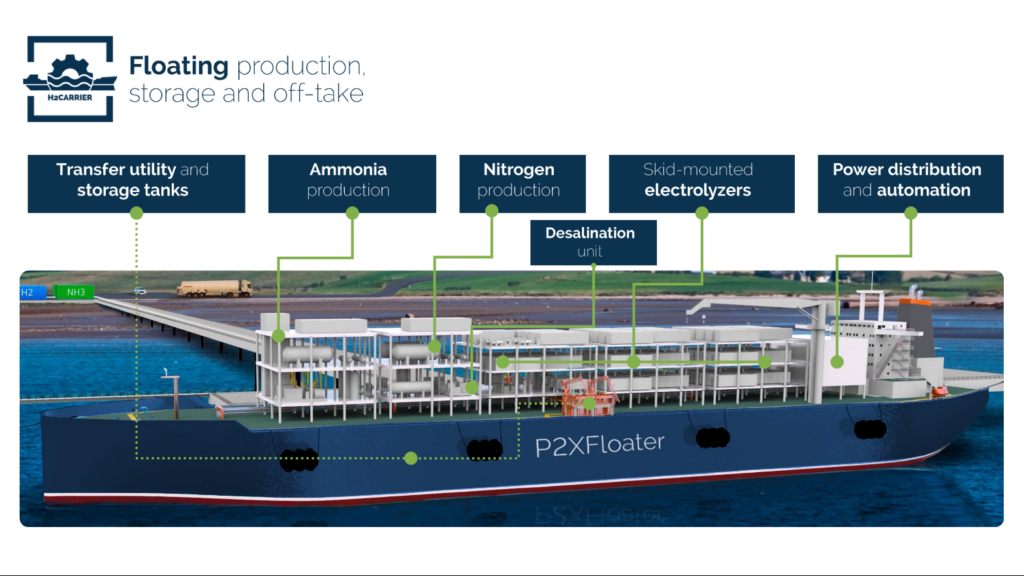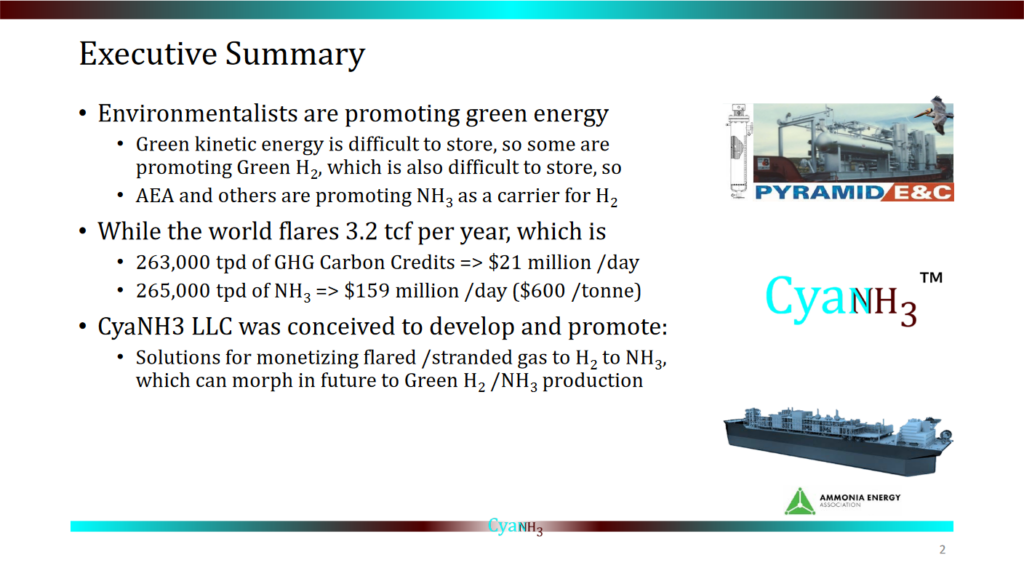Enabling offshore production: jetty-less terminals & floating ammonia factories
By Sofia Furstenberg Stott on February 10, 2023
When you hear the phrase “offshore energy”, you immediately think of oil & gas platforms, or even wind turbines anchored out at sea. But hydrogen & ammonia production, storage and export assets are poised to join them, thanks to the work of several companies. To close out Maritime Ammonia Insights in 2022, we explored these developments with a prominent trio of speakers: Philippe Lavagna
(SBM/Imodco), Sebastian Kihle (H2Carrier) and Puneet Sharma (CyaNH3). You can watch a replay of the webinar, and also download the speaker presentations.
Jetty-less exports
First, let’s look at SBM/Imodco. SBM Offshore is a company with a vast presence worldwide in offshore floating production and storage. One of its daughter companies (Imodco) delivers so-called jettyless export terminals based on single-point mooring. These have a clever name, CALM, an acronym for Catenary Anchor Leg Mooring.

An anchored buoy performs the dual function of keeping a tanker moored while also transferring fluids, from tanker-to-shore (and vice versa) via a subsea pipeline, while allowing the ship to “weathervane”1. This is the key advantage of a single-point system, as it allows for the bulk transfer of liquids in changing weather conditions, and without the need for a fixed terminal. Another advantage to jetty-less terminals is that , as they can be placed further out to sea, safety distances are not the same concern, dredging is usually not necessary, and the system can be delivered faster and with less decommissioning costs.
This type of system is now being evaluated to function safely during the transfer of ammonia. A qualification process has resulted in AiPs from DNV and ABS, and testing is now being carried out to finalize the design. This includes finalizing the fluid transfer technology, the subsea valves and subsea hoses configurations. The emergency shutdown valve is a critical component. This has to be able to handle temperatures of negative 33 degrees Celsius – the ambient storage temperature for ammonia.
The P2X Floater

Next up is H2Carrier, the Norwegian company behind the PtX Floater vessel design for ammonia production. According to H2Carrier, it will be “the first industrial scale floating green hydrogen and ammonia facility of its kind in the world”. The concept is based on proven floating production, storage and off-take technologies combined with an e-control system capable of balancing renewable electricity feedstock through a fully integrated PEM and Haber-Bosch system.
H2Carrier received AiP from DNV earlier last year, and the company attempts to provide end-to-end management services through their P2X Floaters, including developing renewable energy supply, providing offtake agreement, procurement, contracting and installation, production, distribution and decommissioning. H2Carrier has also signed a recent MoU to explore offshore ammonia production in Greenland, powered by energy from the country’s first commercial onshore wind farm.
Utilizing stranded gas-flaring
Last up, CyaNH3. Offshore gas flaring emits unnecessary climate gasses into the atmosphere. When LNG is not an option, offshore production of blue ammonia could be a viable case. CyaNH3 sees an opportunity to deploy blue ammonia Floating Production Storage and Offloading (FPSO) vessels, commercially viable at 15,000 tonnes per day. CyaNH3 have identified that for the vessel’s topside, green and blue ammonia shares 80% of the necessary infrastructure, so there are long-term synergies to explore for designing ammonia FSPOs.

With CyaNH3’s FPSO vessel design, the idea is to produce blue ammonia from these offshore gas flaring sites, which are typically located over such widespread areas that LNG production isn’t economically feasible. The real challenge is that existing hull forms are not feasible for ammonia FPSOs. A new hull form is necessary for the ammonia storage, similar but not identical to a typical FPSO hull form.
So far, CyaNH3 has delivered an opportunity assessment for offshore green hydrogen production in Scotland, identified a number of flaring & stranded gas opportunities, developed a conceptual design for a small FPSO vessel, and applied to patent their Cyan NH360 FPSO Hull.
Why is the floating production of ammonia such an interesting idea? Why place this industry offshore in a difficult environment, when you may otherwise choose the usual (less complicated) option of placing it ashore? How can the vast capabilities available in the existing offshore energy industry be leveraged to leap ahead?
Renewable energy can be stranded in hard-to-reach areas, or with limited capacity to transmit it onto central grids. These scenarios are the target applications for H2Carrier. “The problem is not to produce the energy, it is to deliver the energy”, Sebastian Kihle says.
Puneet Sharma adds a benefit of offshore ammonia over LNG. In a world with increasingly harsh weather & significant wave heights, floating LNG will not work, as transfer hoses won’t work under extreme conditions. Due to the different chemical and physical properties of ammonia, it is easier to offload in difficult conditions.
There’s another benefit of floating ammonia over LNG too: if you produce LNG on a floating unit, you typically lose 10% as a boil-off. This is certainly not good for the environment, and it has further negative implications given the increasing rate of carbon taxation. Translating stranded gas resources into ammonia “could be a goldmine”, Puneet suggests.
Philippe Lavagna concludes by reflecting on the long industry experience of transferring ammonia from ships to terminals. The difference now, he says, is that “we do it in the open sea and in larger quantities”. This bodes well for the emerging offshore production industry, which should draw on the extensive experience & wisdom already gained. “All we have done in the offshore industry can also be applied for ammonia, using the same pieces of the puzzle.”
- A single-point system allows the ship to change its heading angle in response to disturbances (eg. wind, swell or storms), and maintain its position with minimum control force. This is sometimes called “weathervaning”.